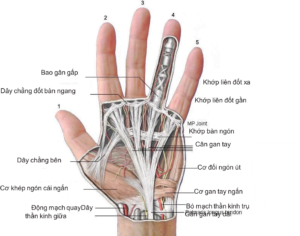OUTLINE
- Hand is an important part of the human body, thanks to the hands that people can use tools in labor and daily life from simple tools to complex tools.
- Anatomically: the hand has a complex structure, in a narrow volume containing many precious organs such as skin, tendons, muscles, blood vessels, nerves, etc.
- Physiologically, the hand has two main functions: grasping and touching. These two functions are closely related and always complement each other.
- Hand injuries are complicated because at the same time, at the same location, there can be many lesions of skin, blood vessels, nerves, tendons and bones.
- Hand wounds are susceptible to infection because most injuries are in a working condition.
- Treatment is very difficult due to the complex injury, easy to infect and at the same time to treat many lesions (blood vessels, nerves, tendons, bones, skin) to restore both function and anatomy.
REMINDER ABOUT MANUFACTURING
These are the basic features, related to the application in clinical practice. Therefore, mastering the anatomy as well as motor function of the hand is very important and necessary.

The flexor tendon of the hand
- These are tendons that are characterized by moving in pulleys, the role of pulleys is to keep the tendons in contact with the surrounding components and have a physiological function for them, and at the same time these pulleys increase the add strength and serve as a fulcrum for tendons when strength is needed.
- The important pulleys are A2 and A4, so when these two pulleys are damaged, they must be restored. The deep common flexor tendon is responsible for folding the 3rd segment into the 2nd segment.
- The shallow common flexor tendon of the fingers folds the 2nd into the 1st.
The extensor tendon of the hand
Muốn kiểm tra một cách chính xác sự vận động của gân duỗi thì phải hạn chế sự vận động của nhóm cơ giun và cơ liên cốt, vì các nhóm cơ này tham gia vào vận động chính của khớp bàn ngón và tham gia vào vận động duỗi của các khớp liên đốt cũng như làm dạng của các ngón tay.
Nerves dominating
- Thần kinh giữa chủ yếu chi phối cho cơ ở cẳng tay trước trừ cơ trụ trước, thần kinh giữa có xu hướng đi dần ra nông và đi dưới dây chằng vòng ở cổ tay và chia cho các nhánh.
- Motor branch of the thumb, excluding adductor major and deep bundle of short flexor muscles, innervates 1 and 2 worms
- Sensory branch for fingers 1, 2, 3, and lateral 1/2 of finger 4.
- Thần kinh trụ chi phối vùng trước trong của cẳng tay sau đi qua rãnh ròng rọc khuỷu, đồng thời chi phối cho bó trong của cơ gấp sâu của ngón 4 và Thần kinh trụ sau khi đi qua ống Guyon thì chia nhánh:
- Motor branch of the labia minora, all interosseous muscles, worms 3 and 4, adductor magnum, and deep bundle of flexor flexor 1
- Sensory branch 1/2 on the ulnar border of the 4th finger and the entire 5th finger.
- Thần kinh quay đi từ trên cánh tay xuống tới mặt trước của khuỷu thì phân nhánh:
The sensory branch is anterior, circumventing the border of the radial bone to branch in the dorsal arm. It governs the thumb, the 1st joint of the 2nd and 3rd fingers, and 1/2 of the 4th finger.
The posterior motor branch innervates all posterior muscles.
Nourishing blood vessels
- Nourishes by the radial artery after passing through the anatomical fossa
- The ulnar artery often accompanies the ulnar nerve
- The anterior interosseous artery is located very deeply and in the middle of the neck
- The radial and ulnar arteries are connected by superficial palmar arch, deep palmar arch, and carpal arch, branching along with the nerve to the distal ends of the fingers with a highly branched characteristic. When there is a vascular injury, an accurate diagnosis is sometimes difficult.
- When there is vascular injury, always think of nerve damage, because nerve pathways are often accompanied by blood vessels.
![Hand Wound 2 Vết Thương Dập Nát Bàn Tay [1]](https://bsvothanhtoan.com/wp-content/uploads/2023/04/Vet-thuong-dap-nat-ban-tay-1-300x208.jpg)
![Hand Wound 3 Vết Thương Dập Nát Bàn Tay (tiếp Theo) [1]](https://bsvothanhtoan.com/wp-content/uploads/2023/04/Vet-thuong-dap-nat-ban-tay-tiep-theo-1-300x199.png)
PRINCIPLES AND ATTITUDE FOR HAND Wound Treatment
General principles
- The structure of the hand is extremely complex, the surgical field is often small, besides there are many components involved
- With delicate injuries such as: partial tendon rupture, lateral nerve injury, vascular injury, joint injury, etc., sometimes it is difficult to detect clinically, it is necessary to have a thorough and complete examination. wound area
- Need to know about: age, occupation, dominant hand, cause of accident, tetanus vaccination or not
- Careful attention should be paid to patients with suicidal thoughts
- Thorough assessment of temperature, color, capillary circulation and especially tendon as well as vascular and nerve damage
- Let's take pictures X-ray with postures: straight, inclined, oblique, to find coordinated damage to the bones as well as foreign bodies if any
- Wash the wound with physiological saline or mixed with Bentadine solution, with heavy bleeding wounds need to be bandaged to stop bleeding, put the hand in a resting position to reduce pain as well as reduce swelling.
- Finally, examine to detect accompanying lesions, if any.
Treatment direction
- Hand injuries, which require immediate treatment, require surgery by specialists as well as in specialized medical facilities.
- Must have a thorough grasp and understanding of hand anatomy as well as surgical principles
- Determining this is the type of surgery that takes a long time
- Sử dụng kính lúp hoặc kính hiển vi phẫu thuật nếu có tổn thương mạch máu thần kinh
- Hand surgery not only ends when the surgery is completed, but the patient needs attention and treatment Rehabilitation next.
Treatment of some types of hand injuries at specialized levels
Skin damage
- When cutting the skin in the palm area, it is very economical. The skin in this area is less elastic, especially in the palm of the hand, if it is cut a lot, it will be missing and cannot be removed on both sides to pull it back. If skin defects need to do plastic surgery to cover.
Some ways to cover skin defects on tables and fingers in emergency:
- Loss of skin at the tip of the finger: if there is little loss, transfer the flap locally from the bottom or sides. The place of sliding up is thin skin grafted or sewn closed
- Nếu mất diện rộng hơn: dùng skin flap có cuống ở mu ngón bên cạnh, ở ô mô cái hoặc ô mô út gan tay hay ở cánh tay,…
- Extensive skin loss on the palm, back of the hand, if it cannot be sutured, must be covered with pedunculated skin flaps. Usually can use inguinal flap, abdominal flap, ...
Cases of skin peeling on the palm or pubic area. If the stalk is still present, we will cut off the peeled skin and wash the warm serum. Incision of the suture mesh and compression bandage. In case of complete loss, use abdominal flaps, inguinal flaps to cover
Injury to blood vessels
It is possible to encounter hand injuries with damage to the superficial palmar artery arch, deep palmar artery arch, finger artery, etc.
- If both lateral arteries of the finger are severed, the finger will be white, wrinkled, and the finger will be smaller than the next finger. When the two finger feeding arteries are injured, we need to actively connect them early by microsurgery technique
- Particularly, vascular lesions in the 3rd vertebrae are often difficult to suture because the arteries are too small, but mainly treated with suturing, fixing the finger firmly and hoping that the tip of the finger will live on the side vessels.
- When an artery is broken in the wrist area – if one of the arteries is broken, it can be ligated. If both are broken, both or one of them must be stitched together.
![Hand Wound 4 Vết Thương đứt Cả Hai động Mạch Bên Của Ngón Tay [2]](https://bsvothanhtoan.com/wp-content/uploads/2023/04/Vet-thuong-dut-ca-hai-dong-mach-ben-cua-ngon-tay-2-300x197.jpg)
Nerve damage
- Depending on the injury, there is an appropriate treatment when breaking nerve branches in the wrist region, for example, rupture of the median, ulnar or radial nerve, we should immediately connect the patient (suture from the bundle or suture. The wrapping depends on the surgeon's ability,…).
- If the damaged nerve cannot be reassembled for suturing, the nerve graft is left for later after 3-4 weeks.
Injury to the flexor tendon
- Thương tổn gân gấp là những thương tổn rất phức tạp. Cả hai gân gấp chung nông và gấp chung sâu cùng nằm trong tendon bag, nên khi bị thương thì bao gân dễ bị viêm và gân sẽ bị dính.
- In case the wound is clean, outside the forbidden area, it is possible to cut the wound, and close the two ends of the tendon, suture all the way to the end. motionless in a relaxed position.
- There are many methods of suturing the flexor tendon such as: the technique of suturing the tendon of Cuneo, Iselin, Kleinert, Kessler Tajma, Sterling-Bunnell.
Injury to the extensor tendon
- A ruptured extensor tendon can be sutured at first and usually gives good results after ablation
- When the extensor tendon ruptures close to the point of attachment, it is enough to immobilize the finger in the maximum extension position for 3 weeks.
Injury to amputate finger
- With amputated tips of toes 1 and 2, we should try to preserve the maximum length, after amputation bones, if skin is missing, you may have to use skin flaps with skin-raising stalks to cover
- The other fingertips are also not stitched. When creating a stump, the scar base should be left on the inner pubic side
- When the stump is the tip of the bone, we need to remove all the cartilage at the tip.



